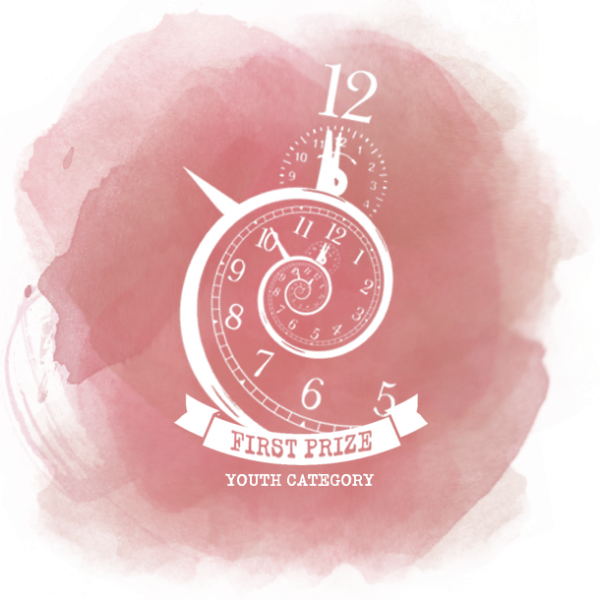Submitted by Nick Maslov
on November 26, 2017

QUANTUM SHORTS 2017: FIRST PRIZE, YOUTH CATEGORY
>> Read an interview with the author
[ENTRY 708]
If you’re reading this, that’s great. I hope you can interpret it. Actually, if you have access to it, you must be able to interpret it. Maybe you’ve overcome entropy and reversed the flow of time itself. Maybe you’ve found a way to survive on nothing but gamma ray photons and the occasional lepton, perhaps forming yourself from them. Good for you. I haven’t.
Here’s a question for you: what is the single most profound statement, ever? Keep that in mind until I come to the punchline. It’s close. I promise.
It’s taken me a while to write this. Time is passing a trillion times faster than what our organic brains would have experienced; supermassive black holes don’t radiate very much energy, so we need to speed things up. Not that time has any meaning now.
I’ve been around for a long while. I was there when our own galaxy wasn’t yet fully colonised. Do you know what a galaxy is? There haven’t been any for aeons. I was there when our local galaxy cluster grouped into just one galaxy. I was there when, because of the universe’s expansion, all others disappeared. Forever.
The last time a star formed was a long time ago. Then again, do you know what a star is? They provided us with lots of energy. I watched the very last one go gentle into that good night. We sat around the dying embers of forgotten fires; got our energy from white dwarfs as they cooled slowly. Then they too were gone.
What do you do when you don’t have enough energy to support your species? The unlucky ones starve. The lucky ones become computers, kept at temperatures as cold as space itself, experiencing time ever faster to reduce their energy needs. I was one of the lucky ones. Survival of the fittest always applies.
The degenerate era really lets you see the universe on its deathbed. Planets (I lived on a planet, once) disappeared over time, their orbits decaying through gravitational waves. There was a brief burst of glory as stellar corpses flooded our central black hole. My God, the energy created was something I had not seen in so long… Those of us left basked and rejoiced in a few precious moments of euphoria. The way we could see all that matter surrounding the black hole was beautiful; the gravitational lensing brought a glowing halo all the way around. But it too went dark. There is nothing but that black hole left now.
It was a short while ago when two words reached me. They are the answer to a simple, age old question, for which there are only two possibilities: yes or no. The single most profound statement, ever. Its proof has taken 10^30 times longer than the lifespan of our species’ original star. Do you want to know what it is? I think you’ve guessed already. Two words:
Protons decay.
[ENTRY 709]
I survive on a trickle of energy from a black hole now. I’m alone, almost omniscient, and cannot overcome the fact that, like everything else in the universe, this black hole’s days are numbered. It’s evaporating, and, worst of all, the rate of evaporation always increases. And with proton decay confirmed, there will be nothing after this black hole. Nothing but photons and a few leptons. Nothing to support me. Dreams of iron stars, of feeding off the quantum tunnelling-based fusion that would happen for incomprehensible periods of time are dashed. I can’t work my way out of this one.
[ENTRY 710]
Apparently my age has doubled since that last log. I’ve accepted my fate, I think. Proton decay has provided me with a last cornucopia of energy, as objects decay in a cascade from heavier elements to pure hydrogen, which will soon disappear as well.
When that black hole finally goes, the amount of energy it releases in its last moments will be… incredible. Of course, I have protons within me. Their decay is random. I just need to hold out.
[ENTRY 711]
I’ve survived so long. I can barely remember my origins. I’ve spent so long here. Am I bored? Perhaps. Scared? Not really. I’ve had plenty of time to get over that. Lonely? There are no stars to keep me company. But then again, I have the entire universe. It’s just so dark…
[ENTRY 712]
I spend most of the time standing by the wall now. It’s my window into all that is. I watched the universe grow from its infancy to its death through it. To think that I stood here, in another body, staring at millions of lights in the sky… Now all my sensors pick up is an occasional photon.
[ENTRY 713]
Systems are gOing. This decay is taking its toll. I should’ve survived a googol years around that black hole. I won’t even live a millionth of that. My life… My purpose is to see thaT last blaze of glory as it evaporates. I can’t die now. It’s still so dark. I’ve lived so long! There are so many things I need to tell you! I’ve seen the Birth of staRs. I’ve seen thEm die. I’ve seen their last remnants fade calmly into the void. I’ve seen the age of neutron stars come and go. The birth and death of millions of civilisations. I’ve seen searing light and pressing dark. I kNow so much. I’ve seen so Much! I could see the light of the universE’s birth. And I AM noW a figmeNt of iTS DeATh it sHOULDn’t enD lIke tHIS
[ENTRY 714]
*ERE WILL BE NO MORE LIGHTIT WONTSEE THE END ITS COMING APART IVE SLOWEDDOWN TIME BUT IT #LY DARKER*OUGHTS FADE LIKE LAST STARS WHENDIED SHIPRETROGRADE I CROSS EVENT HORIZ# FEEL NO PAIN SENSES LOST ITWASB^&##AUTIUL ALL*OSEYEARS BLACK GETSBLACKER IC$^T ISEELIGHTBUT W%&T NO*IN”^^LEFTT! !RMINATNG ADI)EUREM#”MBERME~~##%!*(
[LOG END]
About the Author:
I’m a lover of physics, astronomy, and hard science fiction, hoping to survive to the degenerate era myself.



